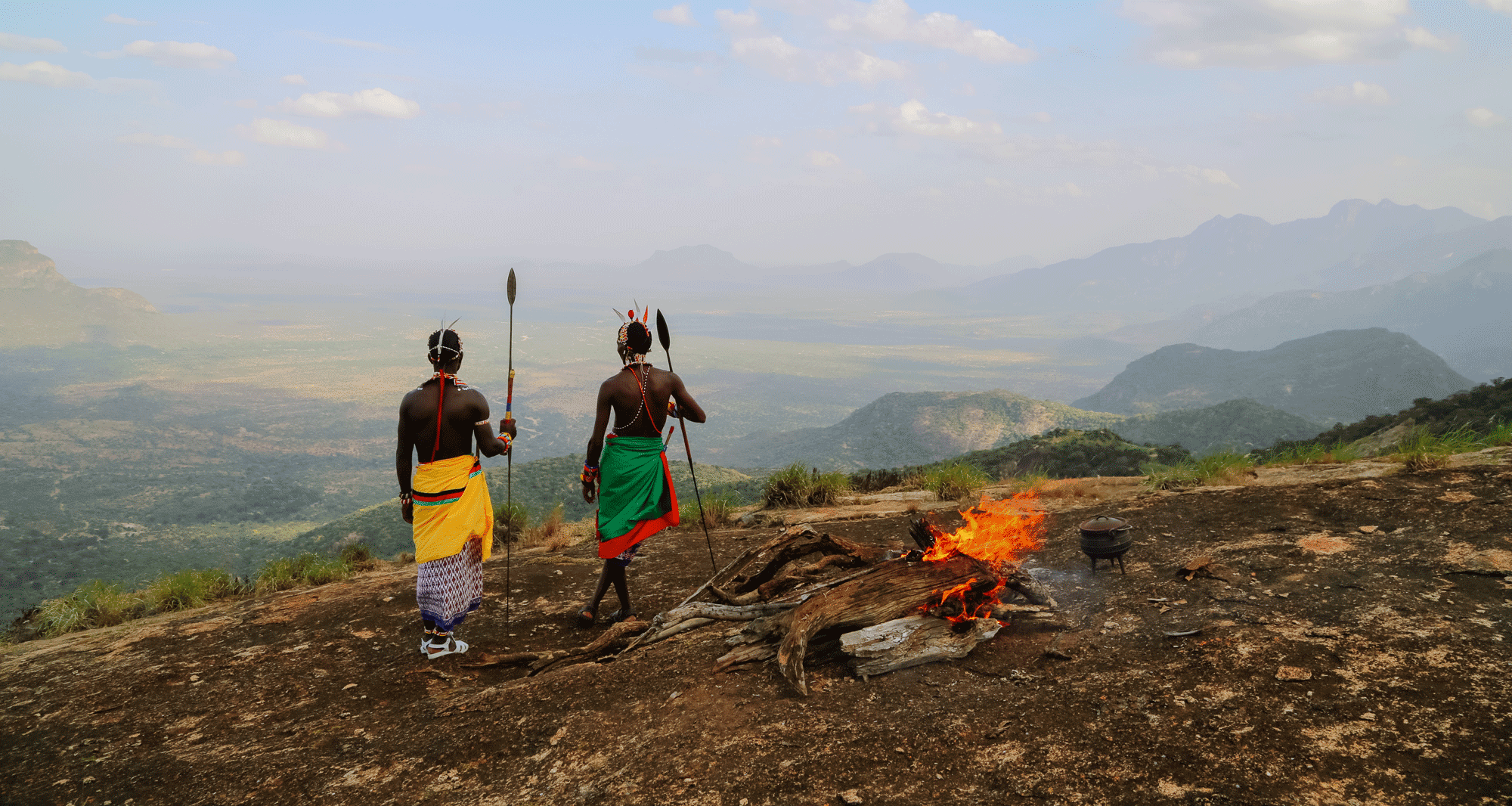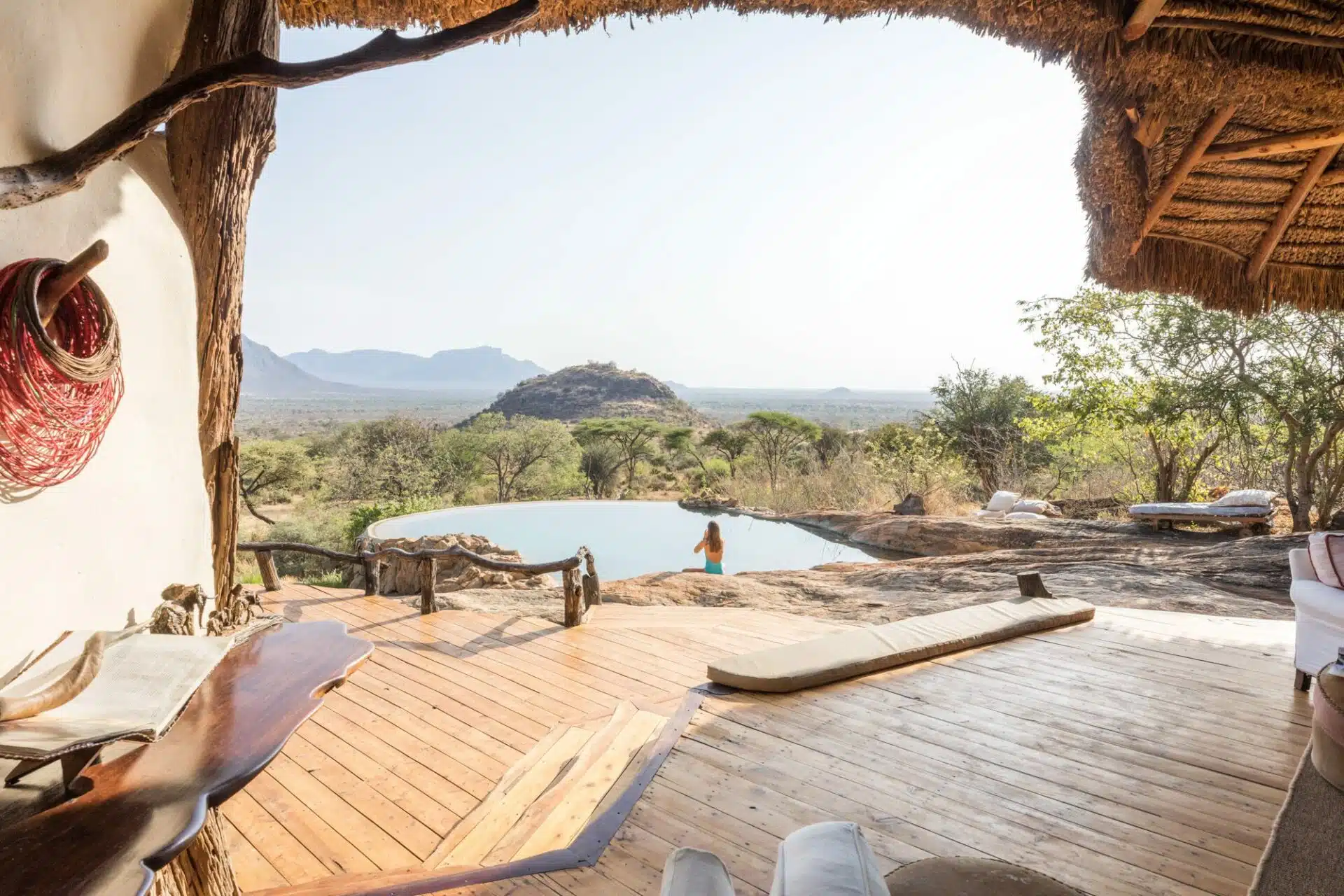SARARA
A Place of Peace
A dark and painful history lurks in the valleys and crags of Matthews Mountain Range.
Located in Northern Kenya, the landscape was once abundant in black rhino, elephant and the many creatures that flocked to these fertile lands. The pastoral Samburu people lived in harmony with their surroundings, respecting the land and its creatures for all that it provided them. They named the region Namanyuk: a Place of Peace.

Warring tribes sought to take the land, forcing the Samburu into ever-diminishing corners of their homelands. Poaching ravaged the fauna, dwindling elephant numbers and eradicating the black rhino completely. Ol Donyo Lenkiyieu, the Samburu name for the Matthews Mountain Range, became a ghostly shadow of the former idyll. The Place of Peace was now a place of nothingness… until just 25 short years ago.
As writer Madeline L’Engle is often quoted, “maybe you have to know the darkness before you can appreciate the light.” And so it was, from these darker times, that Sarara now shines so very brightly.
In 1997, a third-generation Kenyan family migrated to the Namanyuk Nature Conservancy on a mission of salvation, not only for the wildlife and grasslands, but also for the Samburu people. Uniting with the ancient Samburu culture, the family set about creating both an exquisite destination for the conscious traveller and a secure, nurturing, sustainable and rehabilitative reserve.

The task was inordinate, but after two decades, Sarara stands as testament to the viability and success achievable in altruistic conservation.
Sarara describes itself as a community-owned and community-driven conservation initiative in Northern Kenya. The Samburu are integral to the project’s daily operations and future developments, just as they have been throughout its formative years. It stands as a benchmark for the viability, indeed the necessity, of conscious tourism.
Sarara Camp perches in rustic luxury on the escarpments of the Matthews Range, the expansive vistas of the Namanyuk Conservancy reaching far into the distance. Traditionally crafted from local natural materials the central family lodge, Sarara House, is adorned with a grass roof and raw, unhewn timbers, its handcrafted earthen walls uniting it with its natural location. However, this fleeting reflection of traditional African mud huts soon fades as one enters the open spaces of the interior.

Sumptuous armchairs beckon you in to enjoy an afternoon aperitif as you gaze across the rolling hills; a large pool allows you to wallow in your beautiful surroundings, in imitation of the elephant and buffalo of the neighbouring waterhole; open-air baths and showers offer an exquisitely surreal outlook in absolute privacy; your personal staff provide delicious cuisine, impeccable service, indulgent massages and expert guiding throughout the conservancy. Sarara is your own private Eden, blissfully immersed in this now thriving wilderness.
Beyond the family lodge, six impeccably-appointed tents find seclusion amongst the outcrops and shrubs of the hillside, each opening to the untouched wilderness of the valley below. Each boasting an open-air bathroom and shower, the tents open onto their own private terrace, an exclusive viewing platform from which to take in the breathtaking scenery from the moment the sun rises across the grasslands until the second your eyes shutter upon your day of adventure.

Sarara was born from a passion for preservation, protection and conservation, and this infuses every aspect of the Sarara experience. The property itself possesses the smallest of environmental footprints, designed, crafted and managed for the least impact possible without compromising comfort or luxury.
Beyond the camp, a more immersive experience awaits. Woven like vast timber nests into the canopy, a collection of treehouses, no less comfortable or well-appointed than their ground-born peers, present a lofty view of the wooded hillside, bringing an element of adventure into your stay. The sun provides warmth for your running hot water and your commanding position allows you a wonderful vantage point to watch life pass by beneath you.


Sarara is very much an experiential destination, not least in its remarkable accommodations. The Samburu have returned to their harmonious ways, nurturing the wildlife around them and understanding that it is valuable both for a balanced ecosystem and now as a means of investment through ecotourism. Yet the Samburu themselves also offer a fascinating cultural experience. For hundreds of years, the herding tribesmen have dug wells to water their cattle in the arid landscapes. This continual toil takes on a musical slant, the tribesmen singing to their cattle to draw them near to hydrate, their rhythmic chanting almost hypnotic as they tirelessly dig their ‘singing wells’.
In former times, nocturnal visits from elephants were little short of disastrous, their heavy footfall often destroying the wells so devotedly dug in the heat of the day. Today, however, the elephant are welcomed and the singing wells serve as much to slake the thirst of these nighttime visitors as to water the tribe’s cattle.
It is impossible to overlook the wonderful attire of the Samburu, their beaded garments and jewellery presenting vibrant splashes of colour against their dark skin and the greens and terracottas of the landscape. Here too, guests may experience this ancient culture for themselves, the women of the tribe offering beading workshops for guests.

Conservation isn’t achieved simply by introducing conscious tourism; it is the united energies of the Sarara family and the Samburu that have manifested a remarkable transformation in this region once bereft of wildlife.
Despite their bulk and sometimes destructive actions, as evidenced in the repetitive well-digging efforts of the tribesmen, elephant are absolutely vital to a robust and healthy ecosystem. It is their return that has heralded in a new era for this Place of Peace.
Established in 2016, in conjunction with the Sarara’s accommodation element, Reteti Elephant Sanctuary has been instrumental in increasing elephant numbers in Namanyuk Nature Conservancy and the Matthews Range. Protecting against poaching, monitoring herds and caring for sick and orphaned elephant, the work of the Samburu and Reteti has not only repopulated this exquisite region of Kenya, it has created an economy, cultural support and education. It has also generated a unique opportunity for visitors to meet some of Reteti’s guests.

Reteti is not a tourist attraction. It is a sanctuary and orphanage and, as such, the wellbeing of its temporary guests is first and foremost. While a very select number of visitors may meet the elephant, interaction is minimal and visitors are not permitted to handle or pet the young elephant calves. However, with a personal keeper escorting you throughout the sanctuary, you are afforded an opportunity that few get to experience, viewing these adorable babies in close proximity and learning about the incredible work undertaken by Reteti and its staff.

Another chapter in the captivating story of Sarara, Reteti Elephant Sanctuary is as alluring an attraction as the impeccable accommodations of Sarara itself, the unspoiled landscapes and the incredible opportunities presented by this revitalized hidden gem of Kenya.
No matter how brief, any African safari is an experience never to be forgotten, but Sarara reaches far beyond. The Matthews Mountain Range is distinctly individual, itself presenting opportunities found nowhere else. Sarara too has its inimitable charm and appeal. But these elements are only the beginning. With poaching statistics thankfully plummeting, Reteti and the conservation work of Sarara are combining to present a benchmark beyond sustainability. They showcase the ability to combine luxury tourism with beneficial action, rehabilitation and an increasingly radiant future for land, animals and people.
To be a part of this phenomenal formula even for a matter of days is to find a complete immersion in the fragility, the culture and the beauty of Africa, an immersion rarely found in such unmitigated plenitude. It is at once fascinating and empowering and, beyond the luxuriously privileged opportunity of your visit, you take with you the comforting knowledge that you have contributed to the solution, that, from its dark beginnings, you have played your part in returning this Place of Peace to the light.



SARARA | Information
 Samburu County, in which Sarara lies, has a consistent climate varying only a couple of degrees throughout the year, with temperatures averaging 88ºF (31ºC), dropping to 59ºF (15ºC) at night. Samburu has two wet seasons and two dry. June-September is the primary dry season, with January and February also offering drier weather. These latter months are the hottest of the year and also subject to occasional showers.
Samburu County, in which Sarara lies, has a consistent climate varying only a couple of degrees throughout the year, with temperatures averaging 88ºF (31ºC), dropping to 59ºF (15ºC) at night. Samburu has two wet seasons and two dry. June-September is the primary dry season, with January and February also offering drier weather. These latter months are the hottest of the year and also subject to occasional showers.
 Though Sarara is wonderfully suited to photographers, more senior travelers and nature lovers, it is a superb venue for children. Sarara has not been established as a family venue as such, but the exotic treehouse accommodation, the opportunity to view wildlife in close proximity and the cultural education Sarara offers make this an incredible experience for younger guests.
Though Sarara is wonderfully suited to photographers, more senior travelers and nature lovers, it is a superb venue for children. Sarara has not been established as a family venue as such, but the exotic treehouse accommodation, the opportunity to view wildlife in close proximity and the cultural education Sarara offers make this an incredible experience for younger guests.
 The true beauty of Sarara is that it is a functioning conservation project. Animal welfare and cultural sustainability are paramount and this makes Sarara a more profound African experience than many other destinations. Connecting with the Samburu people and learning of their culture, exploring the private reserve and meeting some of the adorable orphaned elephants give you a sense of the remarkable conservation efforts undertaken at this private reserve.
The true beauty of Sarara is that it is a functioning conservation project. Animal welfare and cultural sustainability are paramount and this makes Sarara a more profound African experience than many other destinations. Connecting with the Samburu people and learning of their culture, exploring the private reserve and meeting some of the adorable orphaned elephants give you a sense of the remarkable conservation efforts undertaken at this private reserve.
 Sarara currently boasts two accommodations, Sarara Camp and Sarara Treehouses. The camp is better suited to more senior guests, offering additional comfort, convenience and a larger communal area. Several ensuite tented rooms plus a two-room family lodge.
Sarara currently boasts two accommodations, Sarara Camp and Sarara Treehouses. The camp is better suited to more senior guests, offering additional comfort, convenience and a larger communal area. Several ensuite tented rooms plus a two-room family lodge.
The treehouses are single-bedroom en-suites, again with one family house with interconnected rooms.
 Samburu County, Matthews Mountain Range – northern Kenya
Samburu County, Matthews Mountain Range – northern Kenya
Contact our Travel Designers to discuss incorporating Sarara and Reteti Elephant Sanctuary into your next itinerary.

